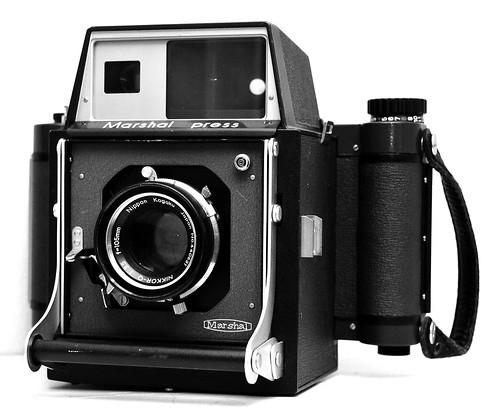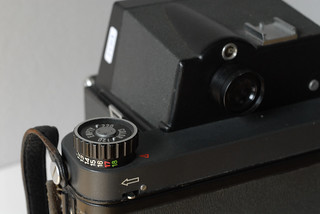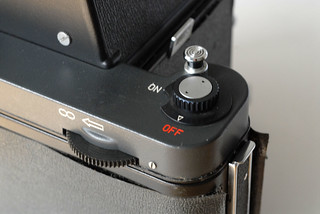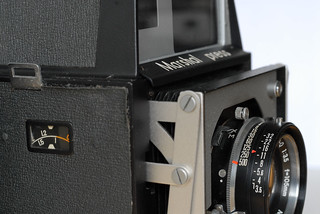Difference between revisions of "Marshal Press"
Rebollo fr (talk | contribs) m (→Links: minor fix) |
m (Deleted heading) |
||
| (17 intermediate revisions by 7 users not shown) | |||
| Line 1: | Line 1: | ||
| − | {{ | + | |
| − | {{ | + | {{Flickr_image |
| + | |image_source= http://www.flickr.com/photos/petertjallinks/4181471710/in/pool-camerawiki/ | ||
| + | |image= http://farm5.staticflickr.com/4001/4181471710_9fbe84b839.jpg | ||
| + | |image_align= right | ||
| + | |image_text= | ||
| + | |image_by= Peter Tjallinks | ||
| + | |image_rights= with permission | ||
| + | }} | ||
| + | |||
| + | Built in the mid 1960s, by Marshal Optical Works, of Japan, the '''Marshal Press''' was a design direct from the brain of [[Mamiya Seiichi|Mr. Seichi Mamiya]]. It is a medium format camera that can take either [[120 film|120 / 220 film]]. | ||
| + | |||
| + | The design resembles a giant [[Mamiya Press]] camera and its coupled rangefinder. It also shows influences of the [[Mamiya#6.C3.976_TLR|Mamiya TLRs]] with its rack and pinion focusing. It uses a permanently mounted 6x9 film back. The lens is a fixed [[Nikkor]]-Q 105mm F3.5 in [[Hattori|Seikosha]] shutter. The shutter is not self-cocking, so it has to be set after each exposure. The lens is focused with a thumb wheel above the film back door of the camera. The focus distance is displayed in a window on the right of the body. Two lens converters were offered, giving a 135mm F4.7, or 150mm F5.6. | ||
| + | {{br}} | ||
| + | |||
| + | {{Flickr_image | ||
| + | |image_source= http://www.flickr.com/photos/tveljus/7145718621/in/pool-camerawiki/ | ||
| + | |image= http://farm8.staticflickr.com/7235/7145718621_949406ca58_n.jpg | ||
| + | |image_align= left | ||
| + | |image_text= exposure counter, film release | ||
| + | |image_by= Tveljus | ||
| + | |image_rights= wp | ||
| + | }} | ||
| + | |||
| + | {{Flickr_image | ||
| + | |image_source= http://www.flickr.com/photos/tveljus/6999632018/in/pool-camerawiki/ | ||
| + | |image= http://farm6.staticflickr.com/5321/6999632018_dbc6b3abec_n.jpg | ||
| + | |image_align= left | ||
| + | |image_text= focus wheel, shutter release, film back release | ||
| + | |image_by= Tveljus | ||
| + | |image_rights= wp | ||
| + | }} | ||
| + | |||
| + | {{Flickr_image | ||
| + | |image_source= http://www.flickr.com/photos/tveljus/6999632268/in/pool-camerawiki/ | ||
| + | |image= http://farm6.staticflickr.com/5032/6999632268_1fae412e08_n.jpg | ||
| + | |image_align= left | ||
| + | |image_text= focus indicator and lens details | ||
| + | |image_by= Tveljus | ||
| + | |image_rights= wp | ||
| + | }} | ||
| + | |||
| + | {{br}} | ||
| + | |||
== Bibliography == | == Bibliography == | ||
* {{Lewis}} P.122. | * {{Lewis}} P.122. | ||
| Line 7: | Line 49: | ||
== Links == | == Links == | ||
| − | |||
| − | |||
In Japanese: | In Japanese: | ||
| + | * [http://www.hayatacamera.co.jp/monthlyphoto/200804/ Marshal Press] at [http://www.hayatacamera.co.jp/ Hayata Camera Laboratory] | ||
| + | * [http://nikomat.org/priv/camera/mednikkor/marshal/marshal.html Marshal Press] in [http://nikomat.org/priv/camera/cameras.html Hiura Shinsaku's camera site] | ||
* [http://mutohide.net/repair/mashalpress.html Marshal Press repair notes] at [http://mutohide.ddo.jp/index.html Handmade and Classic Camera] | * [http://mutohide.net/repair/mashalpress.html Marshal Press repair notes] at [http://mutohide.ddo.jp/index.html Handmade and Classic Camera] | ||
| − | [[Category: Japanese | + | {{Japanese post 1960 medium format VF and RF}} |
| + | |||
| + | [[Category: Japanese 6x9 rangefinder]] | ||
[[Category: M]] | [[Category: M]] | ||
[[Category: press cameras]] | [[Category: press cameras]] | ||
Latest revision as of 09:39, 26 September 2021

|
| image by Peter Tjallinks (Image rights) |
Built in the mid 1960s, by Marshal Optical Works, of Japan, the Marshal Press was a design direct from the brain of Mr. Seichi Mamiya. It is a medium format camera that can take either 120 / 220 film.
The design resembles a giant Mamiya Press camera and its coupled rangefinder. It also shows influences of the Mamiya TLRs with its rack and pinion focusing. It uses a permanently mounted 6x9 film back. The lens is a fixed Nikkor-Q 105mm F3.5 in Seikosha shutter. The shutter is not self-cocking, so it has to be set after each exposure. The lens is focused with a thumb wheel above the film back door of the camera. The focus distance is displayed in a window on the right of the body. Two lens converters were offered, giving a 135mm F4.7, or 150mm F5.6.

|
| exposure counter, film release image by Tveljus (Image rights) |

|
| focus wheel, shutter release, film back release image by Tveljus (Image rights) |

|
| focus indicator and lens details image by Tveljus (Image rights) |
Bibliography
- Lewis, Gordon, ed. The History of the Japanese Camera. Rochester, N.Y.: George Eastman House, International Museum of Photography & Film, 1991. ISBN 0-935398-17-1 (paper), 0-935398-16-3 (hard). P.122.
- McKeown, James M. and Joan C. McKeown's Price Guide to Antique and Classic Cameras, 12th Edition, 2005-2006. USA, Centennial Photo Service, 2004. ISBN 0-931838-40-1 (hardcover). ISBN 0-931838-41-X (softcover). P.653.
- Sugiyama, Kōichi (杉山浩一); Naoi, Hiroaki (直井浩明); Bullock, John R. The Collector's Guide to Japanese Cameras. 国産カメラ図鑑 (Kokusan kamera zukan). Tokyo: Asahi Sonorama, 1985. ISBN 4-257-03187-5. Item 6077.
Links
In Japanese: